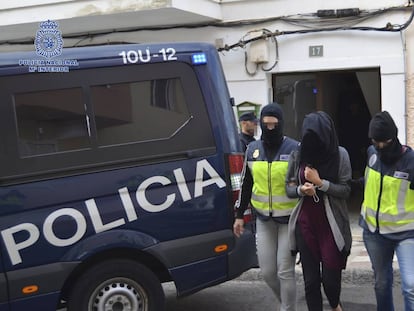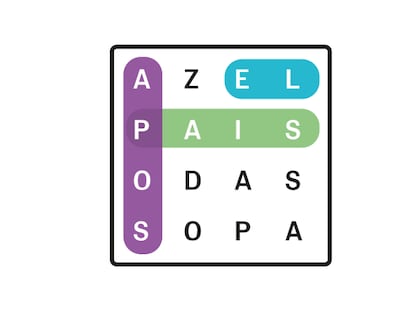Spain launches new counter-terrorism strategy to fight Jihadism and the ¡°rise of extremism¡±
Interior Ministry worried about returning combatants, but says the greatest threat continues to be homegrown terrorist cells


The Spanish Interior Ministry has released a new counter-terrorism strategy that targets jihadist terrorism, focusing specifically on former members of the so-called Islamic State (ISIS) and Al Qaeda who are returning from conflict zones, prisons where petty criminals become radicalized, and homegrown terrorist cells such as the one that perpetrated the 2017 Barcelona attack.
The greatest threat to Spain is ¡°the activity of lone actors and cells radicalized by themselves in Spanish territory¡±
The document, which was published on Tuesday in the Official State Gazette (BOE), also argues that ¡°the rise of identity-based extremism with exclusionary positions¡± is ¡°one of the most worrying issues today¡± because it is ¡°leading to violent dynamics and support for terrorism among minority sectors of our society.¡± It adds that the problem could ¡°increase in the context of financial crisis.¡±
But the text¡¯s primary focus is on the fight against jihadist terrorism, particularly addressing the return of former ISIS and Al Qaeda fighters. Most of these jihadists left their homes principally in Madrid, Catalonia and Spain¡¯s North African exclave cities Ceuta and Melilla to fight in conflict zones like Syria and Iraq. Given the United States¡¯ decision to end its military mission in Syria, it is expected that many of them will now return to Spain.
In Spain, 120 prisoners jailed for common crimes have shown signs of radicalization or completely assumed radical ideology
To manage this threat, the Interior Ministry proposes trying to send the former fighters to prison upon their return. But counter-terrorism sources recognize this will be difficult, given that currently they can only be prosecuted for joining a terrorist organization.
To overcome this, the counter-terrorism strategy proposes incorporating evidence provided by the troops of other countries, be it DNA samples or documents, into court proceedings in Spain. This would allow Spanish prosecutors to charge the former fighters with participating in specific acts of terrorism, something which up to now has not been possible because of a lack of evidence. Germany has taken a similar approach, recently jailing a woman who let a child slave die while she was in an area controlled by ISIS.
According to the document, more than 230 Spanish citizens or residents left the country to fight in conflict zones with terrorist groups. Of those, approximately one fourth have died in combat and 20% have returned to Spain.
The counter-terrorism strategy also takes aim at prisons in Spain, which have proven to be centers for radicalization. In addition to the 140 inmates who have been imprisoned for their involvement in jihadist activities, another 120 prisoners jailed for common crimes like robbery and drug trafficking have shown signs of radicalization or completely assumed radical ideology, according to the Interior Ministry. To address this threat, the plan aims to provide ¡°special attention to penitentiary centers¡± and open the door to increasing the number of guards. It also suggests changes to de-radicalization programs which have had only modest success, with fewer than 15 inmates signed up.
More than 230 Spanish citizens or residents left to fight in conflict zones with terrorist groups
The document also points out that ¡°most of the terrorist attacks committed in Europe were done by people radicalized in their own countries,¡± as was the case with the terrorist attacks in Barcelona and Cambrils in August 2017. It adds that the greatest threat to Spain is ¡°the activity of lone actors and cells radicalized by themselves in Spanish territory.¡±
The new counter-terrorism strategy replaces the previous plan, which was made in 2012 and expired in 2017. The updated document from Interior Minister Fern¨¢ndo Grande-Marlaska reflects the legislative changes that have been made since then, including the approval of the National Security Law in 2015 and the most recent directives from the European Union, as well as ¡°the important transformations¡± observed in recent years in terrorist strategies.
The new plan, which was put together by the Counter-Terrorism and Organized Crime Intelligence Center (CITCO), will be valid until 2023, although it will be open to annual reviews. In an effort to encourage citizen collaboration, the counter-terrorism strategy has been made public for the first time.
English version by Melissa Kitson.
Tu suscripci¨®n se est¨¢ usando en otro dispositivo
?Quieres a?adir otro usuario a tu suscripci¨®n?
Si contin¨²as leyendo en este dispositivo, no se podr¨¢ leer en el otro.
FlechaTu suscripci¨®n se est¨¢ usando en otro dispositivo y solo puedes acceder a EL PA?S desde un dispositivo a la vez.
Si quieres compartir tu cuenta, cambia tu suscripci¨®n a la modalidad Premium, as¨ª podr¨¢s a?adir otro usuario. Cada uno acceder¨¢ con su propia cuenta de email, lo que os permitir¨¢ personalizar vuestra experiencia en EL PA?S.
?Tienes una suscripci¨®n de empresa? Accede aqu¨ª para contratar m¨¢s cuentas.
En el caso de no saber qui¨¦n est¨¢ usando tu cuenta, te recomendamos cambiar tu contrase?a aqu¨ª.
Si decides continuar compartiendo tu cuenta, este mensaje se mostrar¨¢ en tu dispositivo y en el de la otra persona que est¨¢ usando tu cuenta de forma indefinida, afectando a tu experiencia de lectura. Puedes consultar aqu¨ª los t¨¦rminos y condiciones de la suscripci¨®n digital.










































